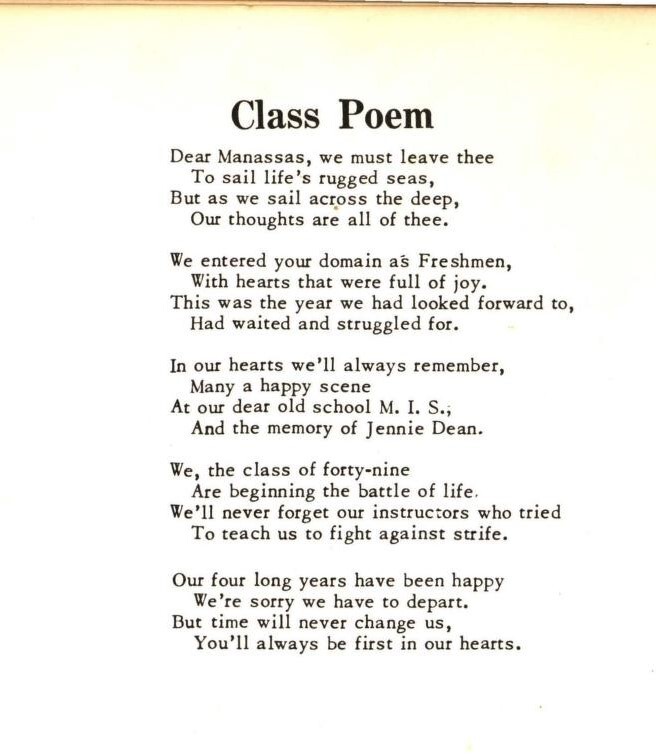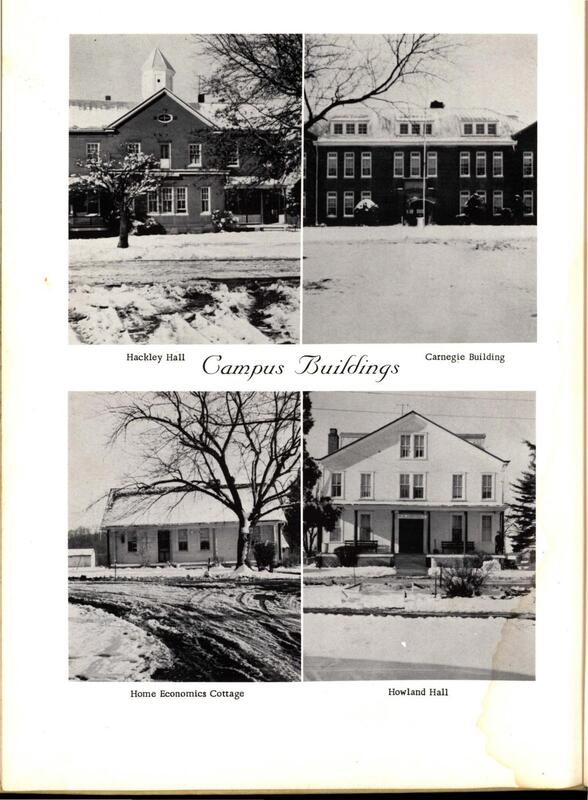Jennie Dean High School
In 1938, Manassas Industrial School became Jennie Dean High School (JDHS). It was a regional high school, owned by Prince William, Fairfax, and Fauquier Counties. As a public high school, it continued to be the only school for Black students in Northern Virginia. Students from Page, Warren, and Rappahannock Counties, as well as, Fort Belvoir, Arlington, and Falls Church continued to be bussed to the school for their education.
A flourishing student life created a community within this high school. Student life began long before a student reached higher education. While the most famous student life organizations for Black students may have been college fraternities and sororities,[1] JDHS had plenty of its own organizations to boast about. In 1950, this included a choir, student council, a school paper, safety patrols, and clubs such as dramatic club, commercial club, home economic club, library club, collegebound club, science club, N.H.A (New Homemakers of America) club, and F.B.A club, as well as athletics such as softball, football, basketball and a cheering squad.[2]
The vibrant student life stands out especially when compared to a white school. Osbourn High School was a nearby school in Manassas open around the same time as Jennie Dean High School. Comparing the 1949 editions of both school’s yearbooks, The Jay Dee and The Hi-Jacket, there are numerous differences. The Jay Dee includes a class poem and a class song. In the poem, the graduating class makes reference to Manassas Industrial School and Jennie Dean herself.[3] The class song includes class colors (green and pink) and a class flower (sweet pea) at the end. They also include “celebrities,” or what are known as superlatives now. The Hi-Jacket, on the other hand, doesn’t have anything similar to a class poem or song. The closest they have to celebrities is a “Hall of Fame,” but this isn’t superlatives like we know them today. Instead, it is a select few seniors with some of their best qualities highlighted.[4]
The Jay Dee also features a prophecy about their graduating class. The prophecy is a prediction of where each member of the class will be in roughly ten years. Sometimes it takes the form of a letter, other times it’s written like a student looking into a crystal ball. The students get creative with their presentation, and it is a tradition that lasts through the last published edition of The Jay Dee, in 1965. The Hi-Jacket makes no such predictions about their graduating seniors.
Other things The Jay Dee includes are a last will and testament, willing certain qualities such as wit and humor to underclassmen, and a history of the graduating class, explaining the major events they have gone through in their schooling. While these yearbooks feature underclassmen and the faculty, it is obvious they are expressions of the community the graduating class made for themselves over the past four years. Osbourn High School’s yearbook doesn’t shine with the same distinct personality that seniors give theirs at Jennie Dean High School. One thing the books have in common are advertisers, though. The schools raised money to publish their yearbooks through the selling of advertisements. They share some of the same advertisers, such as Prince William Bakery, Manassas Ice and Fuel Company, Brumback and Durst Refrigeration, Birmingham Dairy, and others.
It wasn’t until 1954 that Fairfax and Fauquier Counties gave full ownership of the high school to Prince William County after withdrawing all of their students. 1954 was the year that Fairfax County finally built its own high school for Black students, despite Brown v. Board. By this time, Warrenton County, Alexandria, and Arlington had their own segregated schools.[5]
In 1958, students of all ages first began appearing in the yearbook, from high school aged students all the way through first graders.[6] Then in 1960, a new building opened on the site: Jennie Dean High and Elementary School. Previously, the school had been utilizing the original buildings of Manassas Industrial School: Howland Hall, Carnegie Hall, and others. Having been built in the late 1800s and early 1900s though, the buildings severely lacked modern facilities. The new building looked more like a modern school, with classrooms, bathrooms, and a gym. During the 1960s, after a period of unuse, the original buildings of MIS were deemed fire and safety hazards. They were torn down. It wasn’t until a 1994 archeological survey that the foundations for the original buildings were rediscovered.
Manassas schools were integrated slowly through the late 1960s. By 1968, though, there was no longer a use for Jennie Dean High School, and it closed its doors. Jennie Dean Elementary School stayed open until 1975, when Manassas became its own city. The school became Dean Middle School to accommodate the growing population. However, the school changed to an elementary school once more in 1990, keeping the name Jennie Dean Elementary School to this day.
[1] Brian Haynes, “Black Undergraduates in Higher Education: An Historical Perspective,” Metropolitan Universities 17, no. 2 (January 1, 2006): 8–21, https://journals.iupui.edu/index.php/muj/article/view/20252.
[2] Jennie Dean High School, 1950 The Jay Dee (Prince William County, Virginia, 1950), http://archive.org/details/1950TheJayDee.
[3] Jennie Dean High School, 1949 The Jay Dee (Prince William County, Virginia, 1949), http://archive.org/details/1949TheJayDee.
[4] Osbourn High School, 1949 The Hi-Jacket (Prince William County, Virginia, 1949), http://archive.org/details/hijacketthe1949osbo.
[5] Patricia Knock and Dr. Henry Mitchell, Natalie Thompson Sanks Vaughn Interview, July 21, 1992, https://www.alexandriava.gov/historic-alexandria/the-online-oral-history-archive.
[6] Jennie Dean High School, 1958 The Jay Dee (Prince William County, Virginia, 1958), http://archive.org/details/1958TheJayDee.
By Jasper Ramsey



